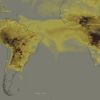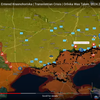Þegar flestir fjölmiðlar, og flestir skólar, endurtaka alltaf sömu fullyrðingarnar, sannar eða ósannar, fara þá fullyrðingarnar upp í sameignlega vitið, og dreifast til allra manna, þegar fjöldinn sem meðtekur boðskapinn nær markhópnum, samanber 100 apa kenningin?*
Er þá hugsanlegt að þegar einhver hefur tök á fjölmiðlum veraldar, nægi þeim aðila að halda áfram og segja alltaf samhangandi falsfréttir?
Ef sami aðili getur haft áhrif á skólakennsluna, þá er hægt að kenna aðeins um þrívíðan, tíma heim, sem er sýndar heimur, en ekki alheimurinn, með sínum fjölvíða raunsannari veruleika heimi.
Ef einn hagsmunahópur, hefur alla hugmyndafræðsluna í sínum höndum, þá ræður hann hugmyndaheimi fólksins.
Þá sýnist að þær hugmyndir, þótt ósannar væru, myndu fara upp í eitthvað vitundasvæði, sem við myndum kalla alheims óvitið, það sem ekki er sannleikur.
Ekki er ólíklegt að við þurfum að læra að greina á milli þess sanna og þess ósanna.
Það sanna kemur frá sannleiksandanum í okkur, og það sem er ósatt, kemur þá frá því sem er ekki satt, í okkur.
Þarna er ég að bera saman kjarnann, the core, sem Nikola Tesla talar um, og þegar Jesú talar um heilagan Anda og Guð, við fjölmiðlaáróðurinn.
Fjölmiðla áróðurinn skapar ósanna heimsmynd, og reynir að koma í veg fyrir að við höfum skýra sýn til sannleikans.
Þess vegna sagði Jesú að, „ sannleikurinn mun gjöra yður frjálsa.“ — Jóhannes 8:32
000
Við færðum Kristnina, fjölvídda heiminn út úr skólunum.
Æskilegt er að þeir sem kenna í skólunum, hafi góða menntun, og kenni eftir allmennt viðurkenndum kennslu aðferðum.
000
slóðir
25.2.2016 | 02:33
000
Stunda hugleiðslu og bæn þá getum við tengt okkur við alheimsvitið. Er Nikola Tesla að segja það?
5.2.2016 | 11:54
000
5.1.2013 | 12:16
000
www.worldtrans.org/pos/monkey.html
The Hundredth Monkey
by Ken Keyes, jr.
The Japanese monkey, Macaca fuscata, had been observed in the wild for a period of over 30 years.
In 1952, on the island of Koshima, scientists were providing monkeys with sweet potatoes dropped in the sand. The monkeys liked the taste of the raw sweet potatoes, but they found the dirt unpleasant.
An 18-month-old female named Imo found she could solve the problem by washing the potatoes in a nearby stream. She taught this trick to her mother. Her playmates also learned this new way and they taught their mothers too.
This cultural innovation was gradually picked up by various monkeys before the eyes of the scientists.
Between 1952 and 1958 all the young monkeys learned to wash the sandy sweet potatoes to make them more palatable.
Only the adults who imitated their children learned this social improvement. Other adults kept eating the dirty sweet potatoes.
Then something startling took place. In the autumn of 1958, a certain number of Koshima monkeys were washing sweet potatoes -- the exact number is not known.
Let us suppose that when the sun rose one morning there were 99 monkeys on Koshima Island who had learned to wash their sweet potatoes.
Let's further suppose that later that morning, the hundredth monkey learned to wash potatoes.
THEN IT HAPPENED!
By that evening almost everyone in the tribe was washing sweet potatoes before eating them.
The added energy of this hundredth monkey somehow created an ideological breakthrough!
But notice.
A most surprising thing observed by these scientists was that the habit of washing sweet potatoes then jumped over the sea --
Colonies of monkeys on other islands and the mainland troop of monkeys at Takasakiyama began washing their sweet potatoes.
Thus, when a certain critical number achieves an awareness, this new awareness may be communicated from mind to mind.
Although the exact number may vary, this Hundredth Monkey Phenomenon means that when only a limited number of people know of a new way, it may remain the conscious property of these people.
But there is a point at which if only one more person tunes-in to a new awareness, a field is strengthened so that this awareness is picked up by almost everyone!
(from the book "The Hundredth Monkey" by Ken Keyes, jr. The book is not copyrighted and the material may be reproduced in whole or in part. You can look at the whole book also.)
Egilsstaðir, 12.05.2018 Jónas Gunnlaugsson







Bæta við athugasemd [Innskráning]
Ekki er lengur hægt að skrifa athugasemdir við færsluna, þar sem tímamörk á athugasemdir eru liðin.